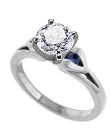Top Sellers
14K White Gold 2.5 mm Contoured Wedding Band

14K Yellow Gold Engraved Engagement Ring with Round Diamonds (.09 ct. tw.)

14K White Gold 3.5 mm Fancy Engagement Ring With Blue Sapphires

https://www.danforthdiamond.com/
Testimonials
I was just checking the status of the ring. I checked online and it says "pending." I don't know if you remember, but I ordered my fiance's engagement ring from you and spoke to you several times on the phone. I would just like to say that she loves the ring and I appreciate your outstanding customer service.
Thank you,
Jarrit
Fluorescence
Not all diamonds fluoresce in the same way. Some diamonds do not fluoresce at all. On diamond grading reports, non-fluorescent diamonds are described as having either "inert" fluorescence or "none".
Of the diamonds which do exhibit fluorescence, the degree of fluorescence can vary from "faint" (a slight glow of color that is difficult to see under ultraviolet light) to "medium" to "strong" to "very strong" (a deep, even flow that is very evident under ultraviolet light).
Even the color of the fluorescence itself can vary from diamond to diamond. Blue is the most common color of fluorescence, which occurs in diamonds, but yellow, green and white are among the other naturally occurring colors of fluorescence. In fact, the famous Hope diamond exhibits a rare, red fluorescence when it is exposed to ultraviolet light.
Is fluorescence a bad thing in a diamond? Not at all. Most of the time, fluorescence doesn't affect a diamond one bit under normal lighting conditions. In 1997 GIA studied 1000 diamonds and the conclusion was that for non-trade observers, the difference between varying levels of fluorescence was indistinguishable. For most consumers, fluorescence had no visible effect on a diamond's color appearance or transparency.
In fact, many people happily own diamonds for their entire lifetimes without ever being aware of the presence or absence of fluorescence in their stones. While most people are a little uncomfortable with the idea of fluorescence when they first hear about it, it is not harmful to you or the diamond, and many find it attractive when they have an opportunity to see it in person.
When choosing a diamond that is near colorless or darker, strong fluorescence can create an aesthetic advantage for customers. In diamonds with these colors, the color of the strong fluorescence actually counteracts the slight yellow body color of the diamond, creating a diamond that appears to be more white or colorless than it actually is. In this case, budget conscious consumers can purchase a lower color but whiter looking diamond for less than they would pay for a higher color diamond with a comparable "face up" appearance, meaning how a diamond looks on the top after being mounted.
Diamonds with no fluorescence or faint fluorescence have no effect on value or appearance. Financially and visually, medium fluorescence has only a slight effect. In some rare cases, very strong fluorescence may create a foggy or "oily" appearance that detracts from the brilliance of the diamond. However, such diamonds account for only about 2% of all gem quality diamonds on the market. We will eliminate any diamonds with high fluorescence that negatively affects the diamonds, so that you don't have to.
